Getting More Out of Queries
About this module
You have learned how to query nodes and relationships in a graph using simple patterns.
You learned how to use node labels, relationship types, and properties to filter your queries.
Cypher provides a rich set of MATCH clauses and keywords you can use to get more out of your queries.
At the end of this module, you will write Cypher statements to:
-
Filter queries using the
WHEREclause -
Control query processing
-
Control what results are returned
-
Work with Cypher lists and dates
Filtering queries using WHERE
You have learned how to specify values for properties of nodes and relationships to filter what data is returned from the MATCH and RETURN clauses.
The format for filtering you have learned thus far only tests equality, where you must specify values for the properties to test with.
What if you wanted more flexibility about how the query is filtered?
For example, you want to retrieve all movies released after 2000, or retrieve all actors born after 1970 who acted in movies released before 1995.
Most applications need more flexibility in how data is filtered.
The most common clause you use to filter queries is the WHERE clause that follows a MATCH clause.
In the WHERE clause, you can place conditions that are evaluated at runtime to filter the query.
Previously, you learned to write simple query as follows:
MATCH (p:Person)-[:ACTED_IN]->(m:Movie {released: 2008})
RETURN p, mHere is one way you specify the same query using the WHERE clause:
MATCH (p:Person)-[:ACTED_IN]->(m:Movie)
WHERE m.released = 2008
RETURN p, mIn this example, you can only refer to named nodes or relationships in a WHERE clause so remember that you must specify a variable for any node or relationship you are testing in the WHERE clause.
The benefit of using a WHERE clause is that you can specify potentially complex conditions for the query.
For example:
MATCH (p:Person)-[:ACTED_IN]->(m:Movie)
WHERE m.released = 2008 OR m.released = 2009
RETURN p, mSpecifying ranges in WHERE clauses
Not only can the equality = be tested, but you can test ranges, existence, strings, as well as specify logical operations during the query.
Here is an example of specifying a range for filtering the query:
MATCH (p:Person)-[:ACTED_IN]->(m:Movie)
WHERE m.released >= 2003 AND m.released <= 2004
RETURN p.name, m.title, m.releasedHere is the result:
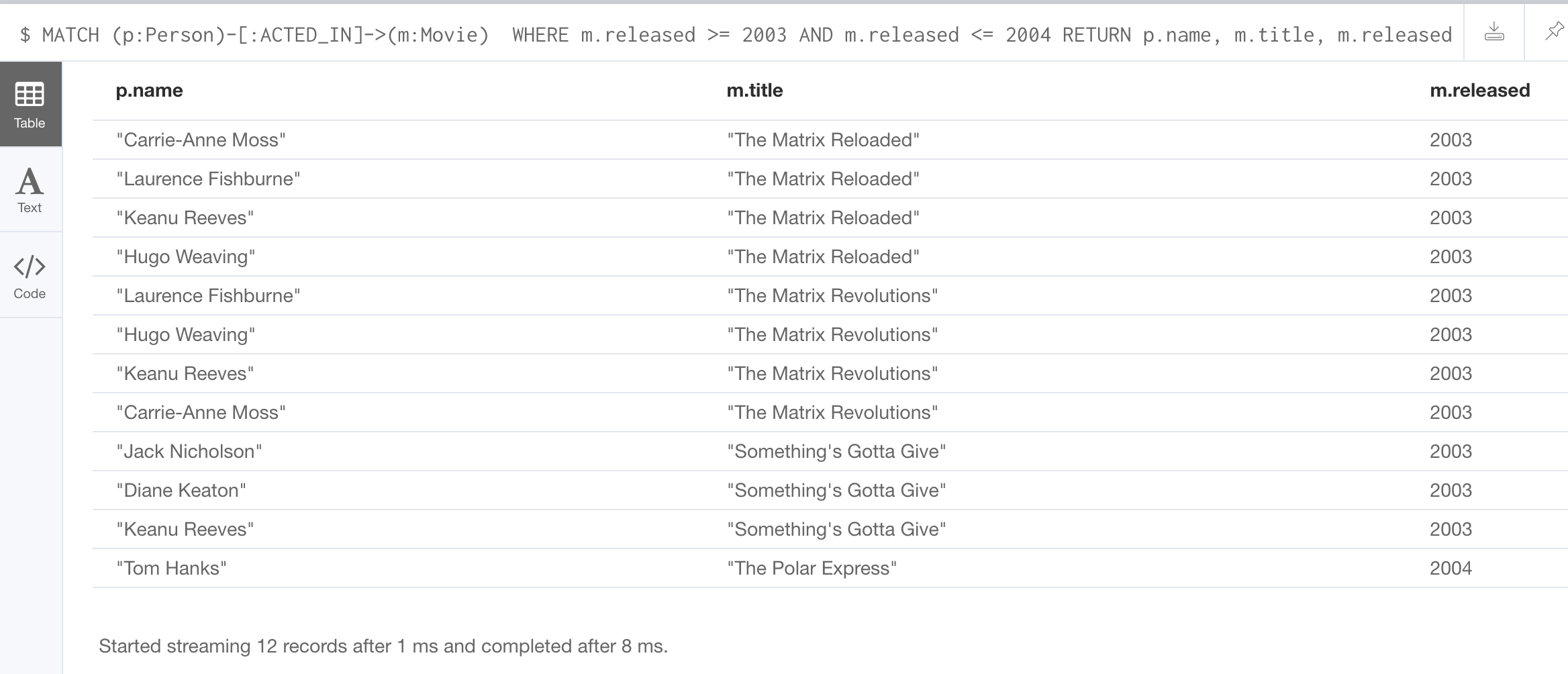
You can also specify the same query as:
MATCH (p:Person)-[:ACTED_IN]->(m:Movie)
WHERE 2003 <= m.released <= 2004
RETURN p.name, m.title, m.releasedYou can specify conditions in a WHERE clause that return a value of true or false (for example predicates).
For testing numeric values, you use the standard numeric comparison operators. Each condition can be combined for runtime evaluation using the boolean operators AND, OR, XOR, and NOT.
There are a number of numeric functions you can use in your conditions.
See the Neo4j Cypher Manual’s section Mathematical Functions for more information.
A special condition in a query is when the retrieval returns an unknown value called null.
Read the Neo4j Cypher Manual’s section Working with null to understand how null values are used at runtime.
Testing labels
Thus far, you have used the node labels to filter queries in a MATCH clause.
You can filter node labels in the WHERE clause also:
For example, these two Cypher queries:
MATCH (p:Person)
RETURN p.nameMATCH (p:Person)-[:ACTED_IN]->(:Movie {title: 'The Matrix'})
RETURN p.namecan be rewritten using WHERE clauses as follows:
MATCH (p)
WHERE p:Person
RETURN p.nameMATCH (p)-[:ACTED_IN]->(m)
WHERE p:Person AND m:Movie AND m.title='The Matrix'
RETURN p.nameNot all node labels need to be tested during a query, but if your graph has multiple labels for the same node, filtering it by the node label will provide better query performance.
Testing the existence of a property
Recall that a property is associated with a particular node or relationship. A property is not associated with a node with a particular label or relationship type. In one of our queries earlier, we saw that the movie "Something’s Gotta Give" is the only movie in the Movie database that does not have a tagline property. Suppose we only want to return the movies that the actor, Jack Nicholson acted in with the condition that they must all have a tagline.
Here is the query to retrieve the specified movies where we test the existence of the tagline property:
MATCH (p:Person)-[:ACTED_IN]->(m:Movie)
WHERE p.name='Jack Nicholson' AND exists(m.tagline)
RETURN m.title, m.taglineHere is the result:

Testing strings
Cypher has a set of string-related keywords that you can use in your WHERE clauses to test string property values.
You can specify STARTS WITH, ENDS WITH, and CONTAINS.
For example, to find all actors in the Movie database whose first name is Michael, you would write:
MATCH (p:Person)-[:ACTED_IN]->()
WHERE p.name STARTS WITH 'Michael'
RETURN p.nameHere is the result:

Note that the comparison of strings is case-sensitive.
There are a number of string-related functions you can use to further test strings.
For example, if you want to test a value, regardless of its case, you could call the toLower() function to convert the string to lower case before it is compared.
MATCH (p:Person)-[:ACTED_IN]->()
WHERE toLower(p.name) STARTS WITH 'michael'
RETURN p.name| In this example where we are converting a property to lower case, if an index has been created for this property, it will not be used at runtime. |
See the String functions section of the Neo4j Cypher Manual for more information. It is sometimes useful to use the built-in string functions to modify the data that is returned in the query in the RETURN clause.
Testing with regular expressions
If you prefer, you can test property values using regular expressions.
You use the syntax =~ to specify the regular expression you are testing with.
Here is an example where we test the name of the Person using a regular expression to retrieve all Person nodes with a name property that begins with 'Tom':
MATCH (p:Person)
WHERE p.name =~'Tom.*'
RETURN p.nameHere is the result:

| If you specify a regular expression. The index will never be used. In addition, the property value must fully match the regular expression. |
Testing with patterns
Sometimes during a query, you may want to perform additional filtering using the relationships between nodes being visited during the query. For example, during retrieval, you may want to exclude certain paths traversed.
You can specify a NOT specifier on a pattern in a WHERE clause.
Here is an example where we want to return all Person nodes of people who wrote movies:
MATCH (p:Person)-[:WROTE]->(m:Movie)
RETURN p.name, m.titleHere is the result:
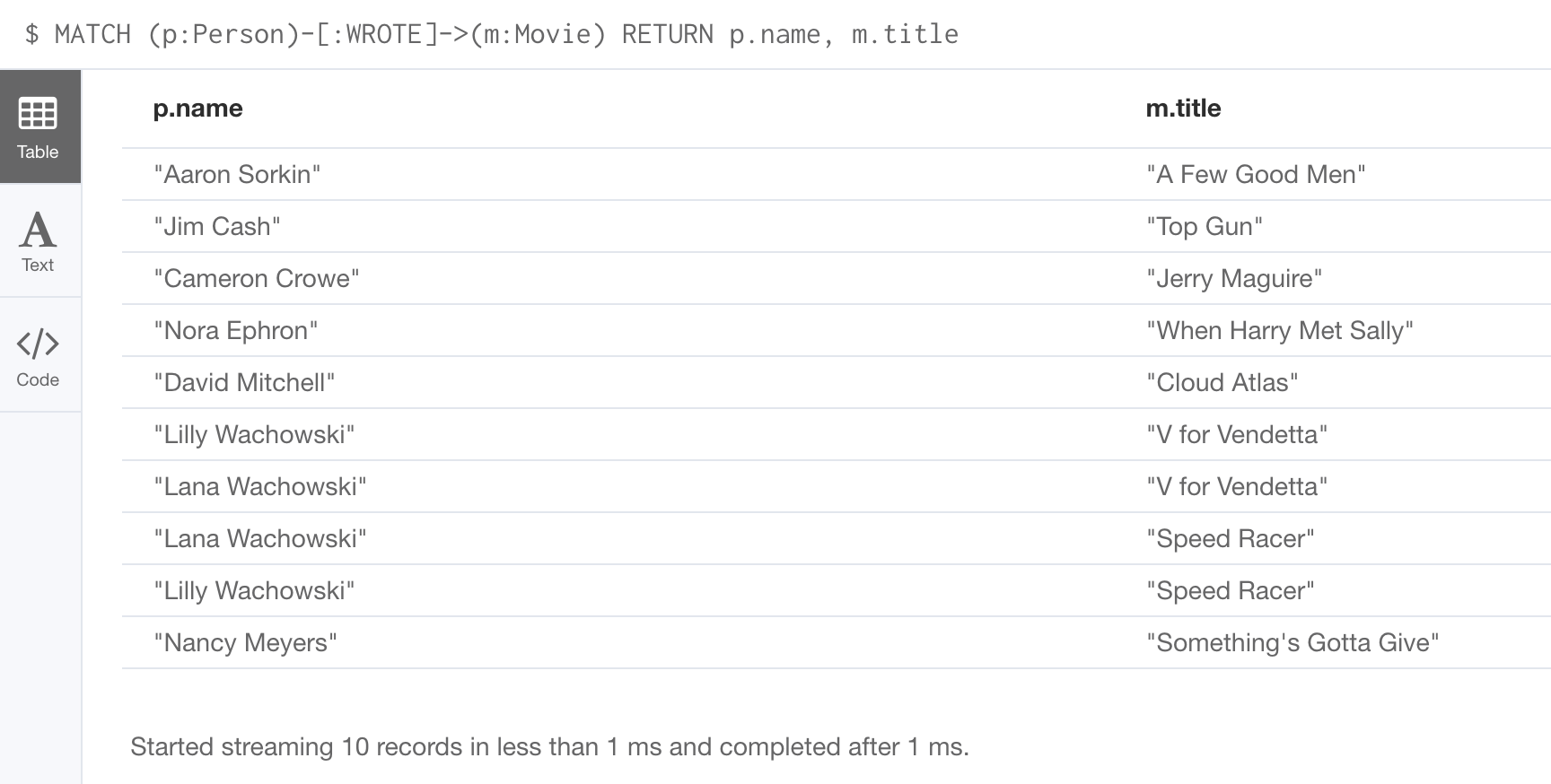
Next, we modify this query to exclude people who directed that movie:
MATCH (p:Person)-[:WROTE]->(m:Movie)
WHERE NOT exists( (p)-[:DIRECTED]->(m) )
RETURN p.name, m.titleHere is the result:
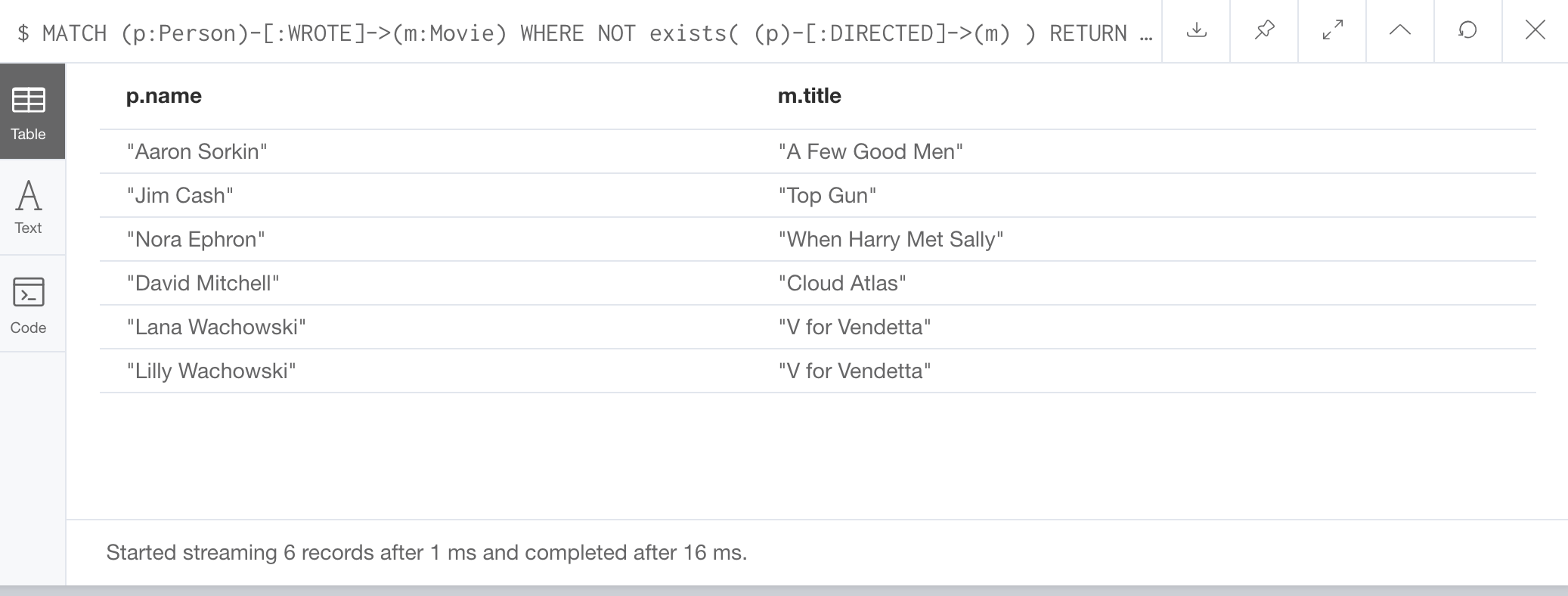
Here is another example where we want to find Gene Hackman and the movies that he acted in with another person who also directed the movie.
MATCH (gene:Person)-[:ACTED_IN]->(m:Movie)<-[:ACTED_IN]-(other:Person)
WHERE gene.name= 'Gene Hackman'
AND exists( (other)-[:DIRECTED]->(m) )
RETURN gene, other, mHere is the result:
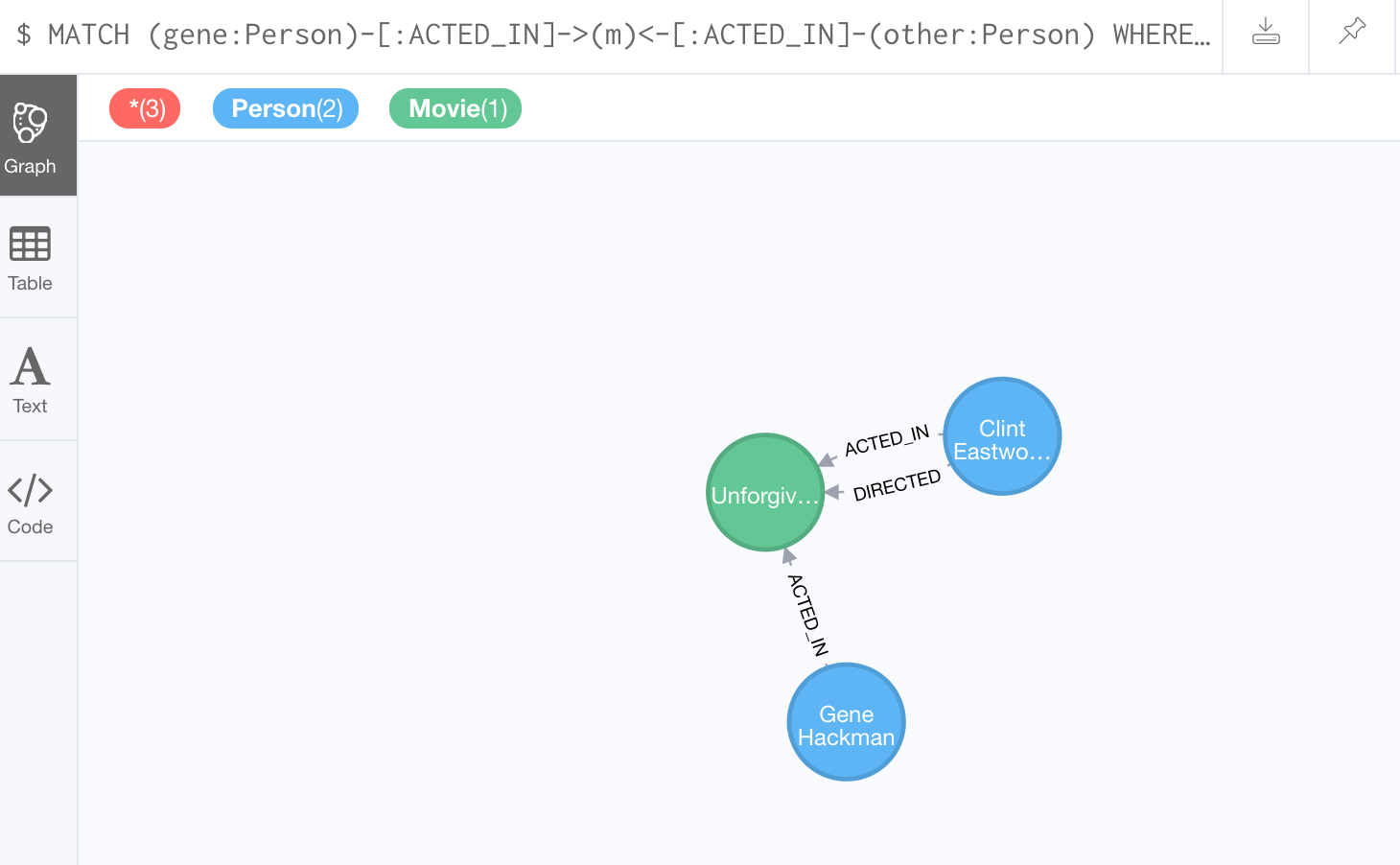
Testing with list values
If you have a set of values you want to test with, you can place them in a list or you can test with an existing list in the graph.
You can define the list in the WHERE clause.
During the query, the graph engine will compare each property with the values IN the list.
You can place either numeric or string values in the list, but typically, elements of the list are of the same type of data.
If you are testing with a property of a string type, then all the elements of the list will be strings.
In this example, we only want to retrieve Person nodes of people born in 1965 or 1970:
MATCH (p:Person)
WHERE p.born IN [1965, 1970]
RETURN p.name as name, p.born as yearBornHere is the result:
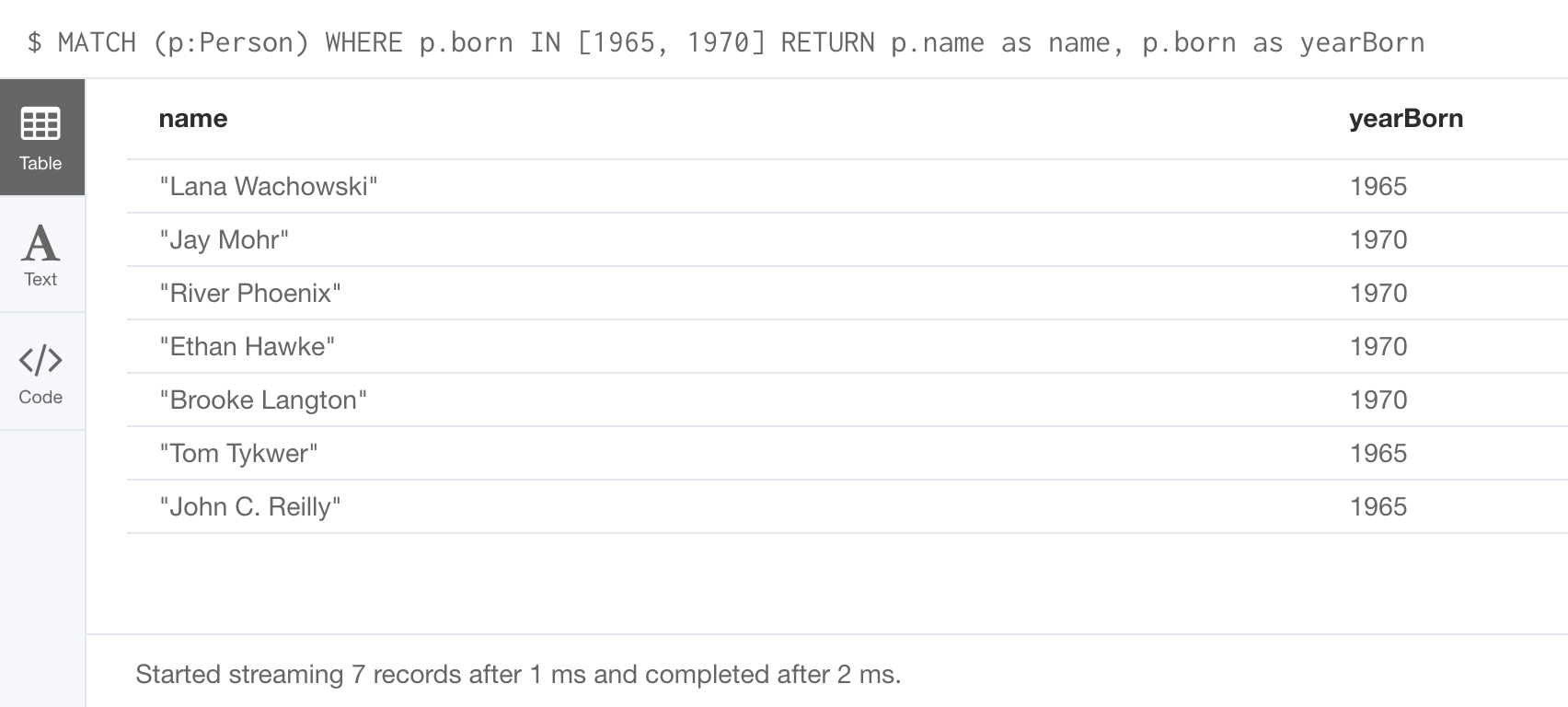
You can also compare a value to an existing list in the graph.
We know that the :ACTED_IN relationship has a property, roles that contains the list of roles an actor had in a particular movie they acted in. Here is the query we write to return the name of the actor who played Neo in the movie The Matrix:
MATCH (p:Person)-[r:ACTED_IN]->(m:Movie)
WHERE 'Neo' IN r.roles AND m.title='The Matrix'
RETURN p.nameHere is the result:

There are a number of syntax elements of Cypher that we have not covered in this training. For example, you can specify CASE logic in your conditional testing for your WHERE clauses. You can learn more about these syntax elements in the Neo4j Cypher Manual and the Cypher Refcard.
|
Exercise 4: Filtering queries using the WHERE clause
In the query edit pane of Neo4j Browser, execute the browser command:
:play intro-neo4j-exercises
and follow the instructions for Exercise 4.
Controlling query processing
Now that you have learned how to provide filters for your queries by testing properties, relationships, and patterns using the WHERE clause, you will learn some additional Cypher techniques for controlling what the graph engine does during the query.
Specifying multiple MATCH patterns
This MATCH clause includes a pattern specified by two paths separated by a comma:
MATCH (a:Person)-[:ACTED_IN]->(m:Movie),
(m:Movie)<-[:DIRECTED]-(d:Person)
WHERE m.released = 2000
RETURN a.name, m.title, d.nameIf possible, you write the same query as follows:
MATCH (a:Person)-[:ACTED_IN]->(m:Movie)<-[:DIRECTED]-(d:Person)
WHERE m.released = 2000
RETURN a.name, m.title, d.nameThere are, however, some queries where you will need to specify two or more patterns. Multiple patterns are used when a query is complex and cannot be satisfied with a single pattern. This is useful when you are looking for a specific node in the graph and want to connect it to a different node. You will learn about creating nodes and relationships later in this training.
Example 1: Using two MATCH patterns
Here are some examples of specifying two paths in a MATCH clause.
In the first example, we want the actors that worked with Keanu Reeves to meet Hugo Weaving, who has worked with Keanu Reeves.
Here we retrieve the actors who acted in the same movies as Keanu Reeves, but not when Hugo Weaving acted in the same movie.
To do this, we specify two paths for the MATCH:
MATCH (keanu:Person)-[:ACTED_IN]->(movie:Movie)<-[:ACTED_IN]-(n:Person),
(hugo:Person)
WHERE keanu.name='Keanu Reeves' AND
hugo.name='Hugo Weaving'
AND NOT (hugo)-[:ACTED_IN]->(movie)
RETURN n.nameWhen you perform this type of query, you may see a warning in the query edit pane stating that the pattern represents a cartesian product and may require a lot of resources to perform the query. Only perform these types of queries if you know the data well and the implications of doing the query.

Here is the result of executing this query:
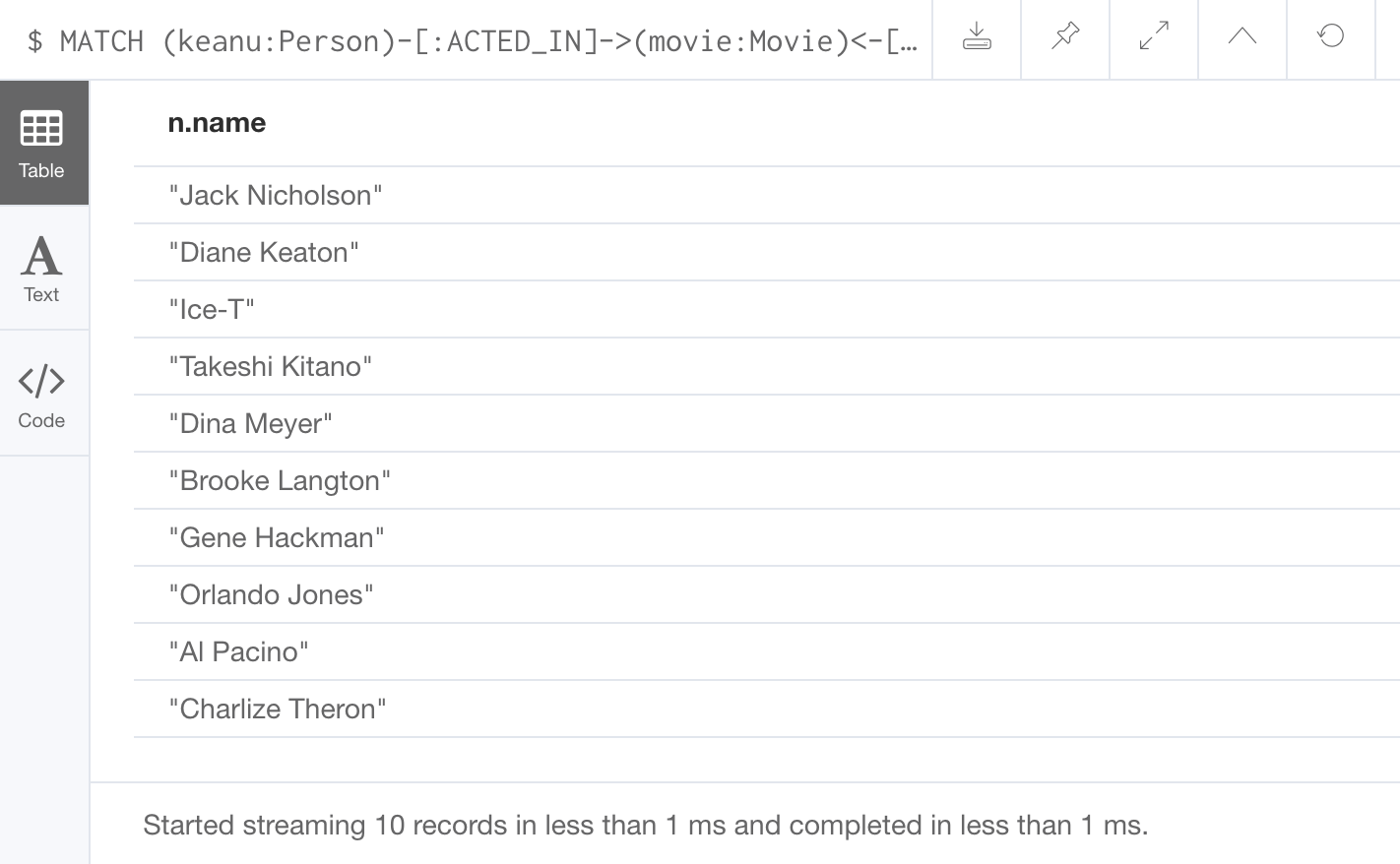
Example 2: Using two MATCH patterns
Here is another example where two patterns are necessary. Suppose we want to retrieve the movies that Meg Ryan acted in and their respective directors, as well as the other actors that acted in these movies. Here is the query to do this:
MATCH (meg:Person)-[:ACTED_IN]->(m:Movie)<-[:DIRECTED]-(d:Person),
(other:Person)-[:ACTED_IN]->(m)
WHERE meg.name = 'Meg Ryan'
RETURN m.title as movie, d.name AS director , other.name AS `co-actors`Here is the result returned:
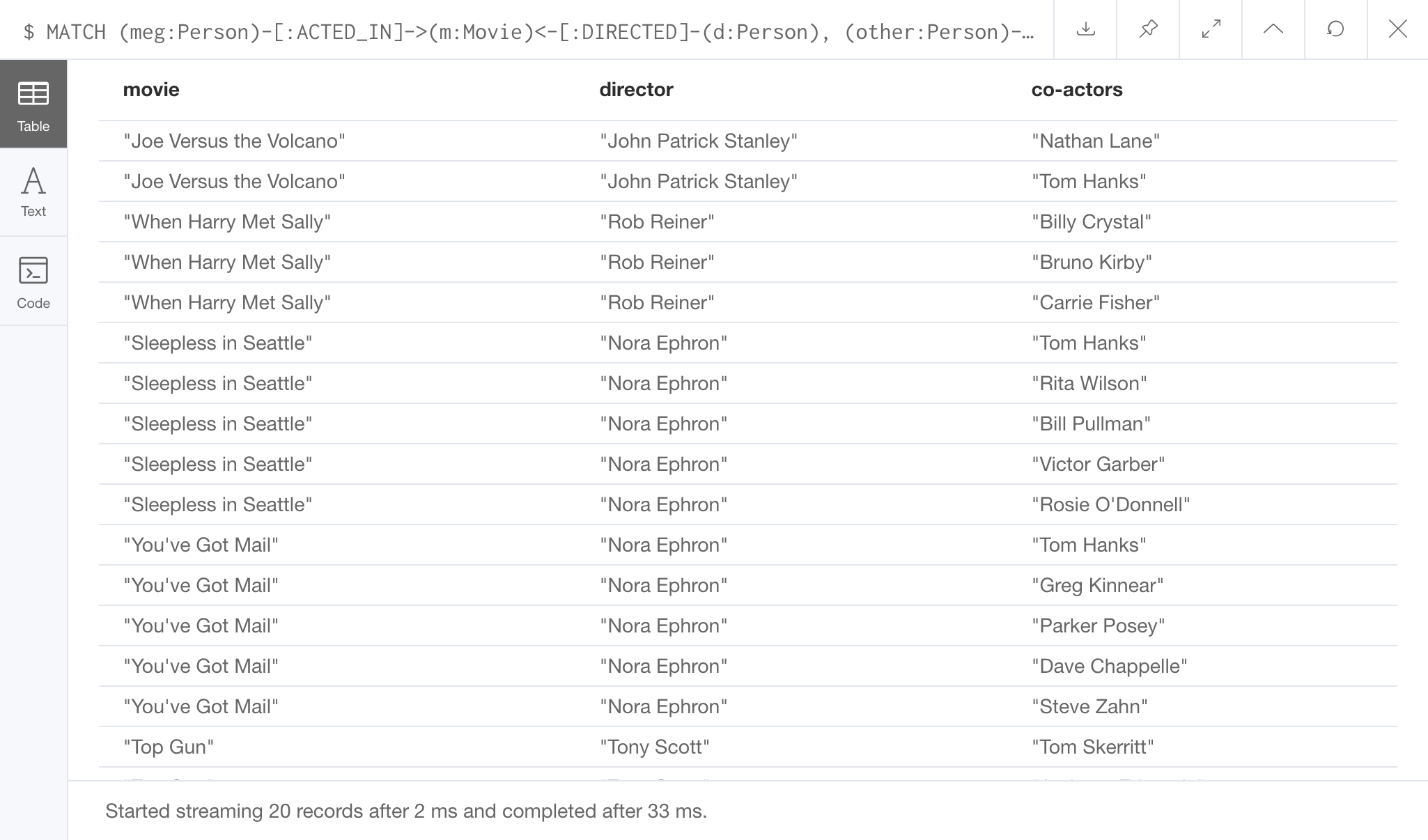
Setting path variables
You have previously seen how you can assign a path used in a MATCH clause to a variable. This is useful if you want to reuse the path later in the same query or if you want to return the path. So the previous Cypher statement could return the path as follows:
MATCH megPath = (meg:Person)-[:ACTED_IN]->(m:Movie)<-[:DIRECTED]-(d:Person),
(other:Person)-[:ACTED_IN]->(m)
WHERE meg.name = 'Meg Ryan'
RETURN megPathHere is the result returned:
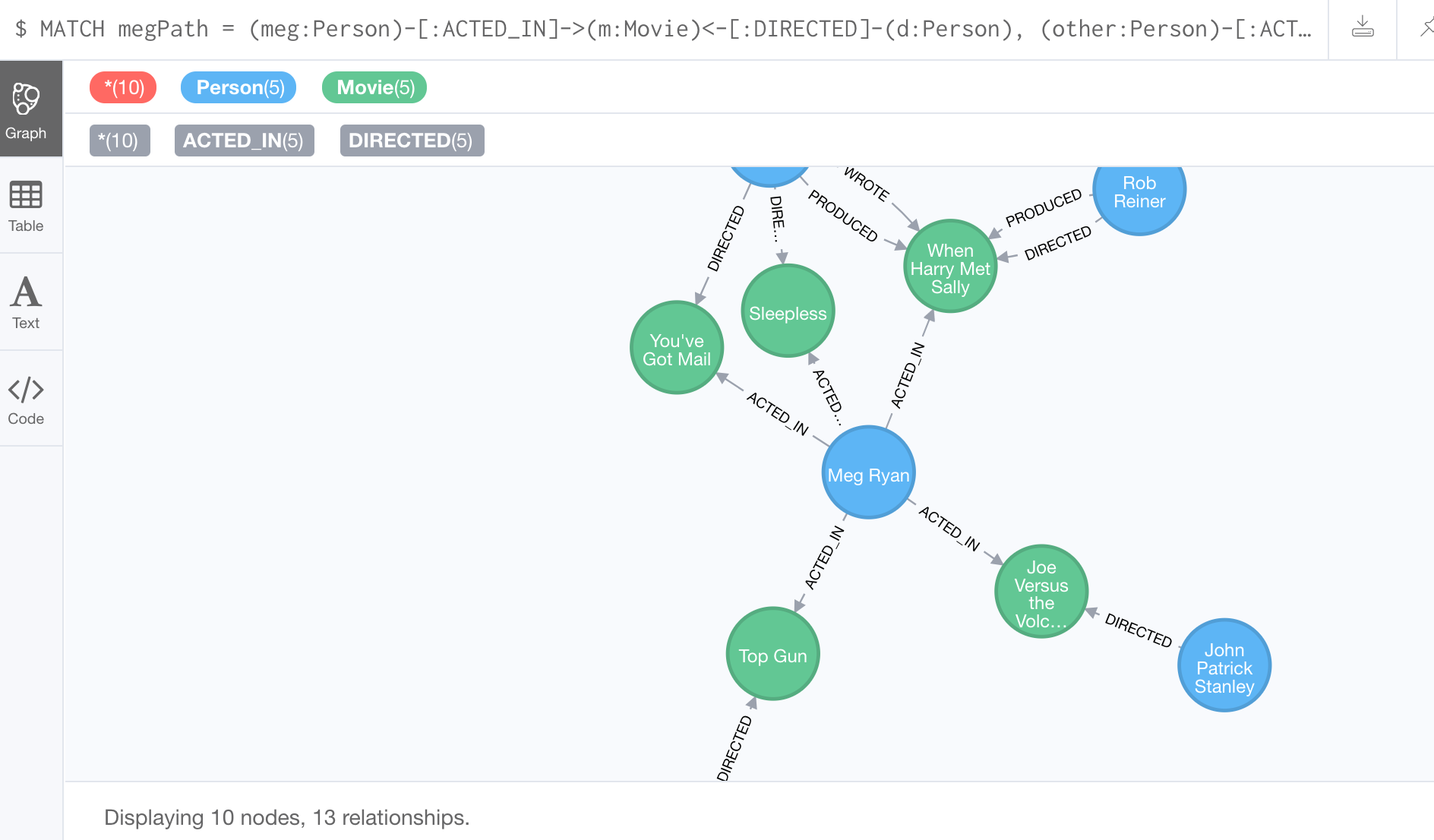
Specifying varying length paths
Any graph that represents social networking, trees, or hierarchies will most likely have multiple paths of varying lengths. Think of the connected relationship in LinkedIn and how connections are made by people connected to more people. The Movie database for this training does not have much depth of relationships, but it does have the :FOLLOWS relationship that you learned about earlier:
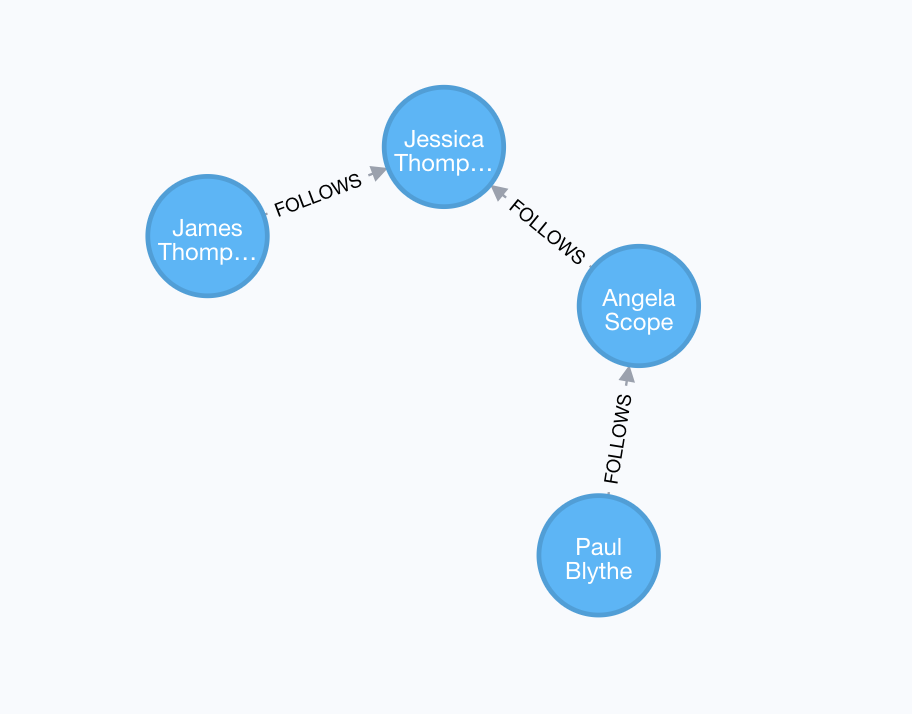
You write a MATCH clause where you want to find all of the followers of the followers of a Person by specifying a numeric value for the number of hops in the path.
Here is an example where we want to retrieve all Person nodes that are exactly two hops away:
MATCH (follower:Person)-[:FOLLOWS*2]->(p:Person)
WHERE follower.name = 'Paul Blythe'
RETURN pHere is the result returned:

If we had specified [:FOLLOWS*] rather than [:FOLLOWS*2], the query would return all Person nodes that are in the :FOLLOWS path from Paul Blythe.
Here are simplified syntax examples for how varying length patterns are specified in Cypher:
Retrieve all paths of any length with the relationship, :RELTYPE from nodeA to nodeB and beyond:
(nodeA)-[:RELTYPE*]->(nodeB)Retrieve all paths of any length with the relationship, :RELTYPE from nodeA to nodeB or from nodeB to nodeA and beyond. This is usually a very expensive query so you place limits on how many nodes are retrieved:
(nodeA)-[:RELTYPE*]-(nodeB)Retrieve the paths of length 3 with the relationship, :RELTYPE from nodeA to nodeB:
(node1)-[:RELTYPE*3]->(node2)Retrieve the paths of lengths 1, 2, or 3 with the relationship, :RELTYPE from nodeA to nodeB, nodeB to nodeC, as well as, nodeC to _nodeD) (up to three hops):
(node1)-[:RELTYPE*1..3]->(node2)You can learn more about varying paths in the Patterns section of the Neo4j Cypher Manual.
Finding the shortest path
A built-in function that you may find useful in a graph that has many ways of traversing the graph to get to the same node is the shortestPath() function. Using the shortest path between two nodes improves the performance of the query.
In this example, we want to discover a shortest path between the movies The Matrix and A Few Good Men. In our MATCH clause, we set the variable p to the result of calling shortestPath(), and then return p. In the call to shortestPath(), notice that we specify * for the relationship. This means any relationship; for the traversal.
MATCH p = shortestPath((m1:Movie)-[*]-(m2:Movie))
WHERE m1.title = 'A Few Good Men' AND
m2.title = 'The Matrix'
RETURN pHere is the result returned:
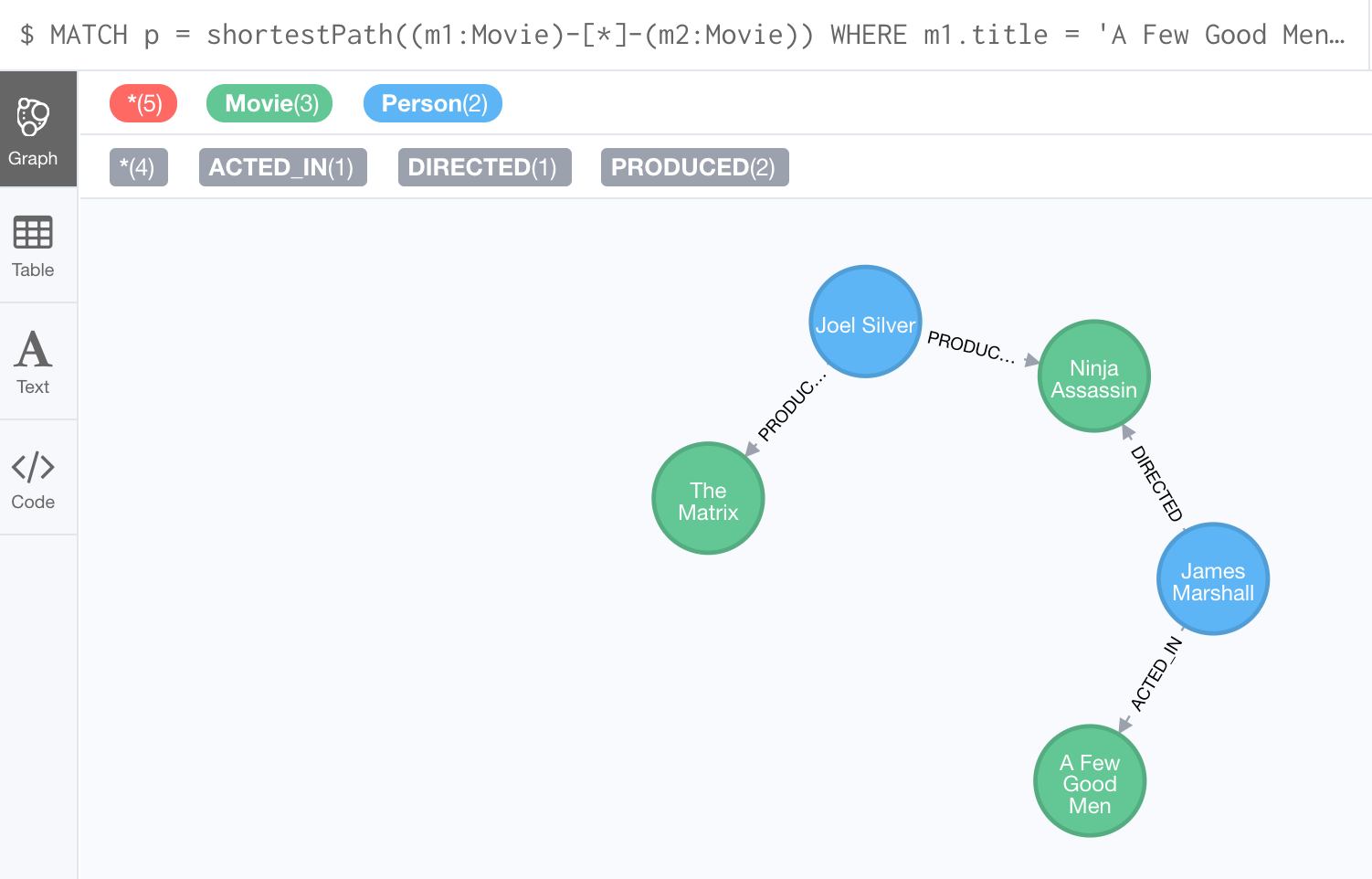
Notice that the graph engine has traversed many types of relationships to get to the end node.
When you use the shortestPath() function, the query editor will show a warning that this type of query could potentially run for a long time. You must heed the warning, especially for large graphs. Read the Graph Algorithms documentation about the shortest path algorithm.
When you use ShortestPath(), you can specify a upper limits for the shortest path. In addition, aim to provide the patterns for the from an to nodes that execute efficiently. For example, use labels and indexes.
Specifying optional pattern matching
OPTIONAL MATCH matches patterns with your graph, just like MATCH does.
The difference is that if no matches are found, OPTIONAL MATCH will use NULLs for missing parts of the pattern.
OPTIONAL MATCH could be considered the Cypher equivalent of the outer join in SQL.
Here is an example where we query the graph for all people whose name starts with James.
The OPTIONAL MATCH is specified to include people who have reviewed movies:
MATCH (p:Person)
WHERE p.name STARTS WITH 'James'
OPTIONAL MATCH (p)-[r:REVIEWED]->(m:Movie)
RETURN p.name, type(r), m.titleHere is the result returned:

Notice that for all rows that do not have the :REVIEWED relationship, a null value is returned for the movie part of the query, as well as the relationship.
Aggregation in Cypher
Aggregation in Cypher is different from aggregation in SQL. In Cypher, you need not specify a grouping key. As soon as an aggregation function is used, all non-aggregated result columns become grouping keys. The grouping is implicitly done, based upon the fields in the RETURN clause.
For example, in this Cypher statement, all rows returned with the same values for a.name and d.name are counted and only returned once.
// implicitly groups by a.name and d.name
MATCH (a)-[:ACTED_IN]->(m)<-[:DIRECTED]-(d)
RETURN a.name, d.name, count(*)With this result returned:
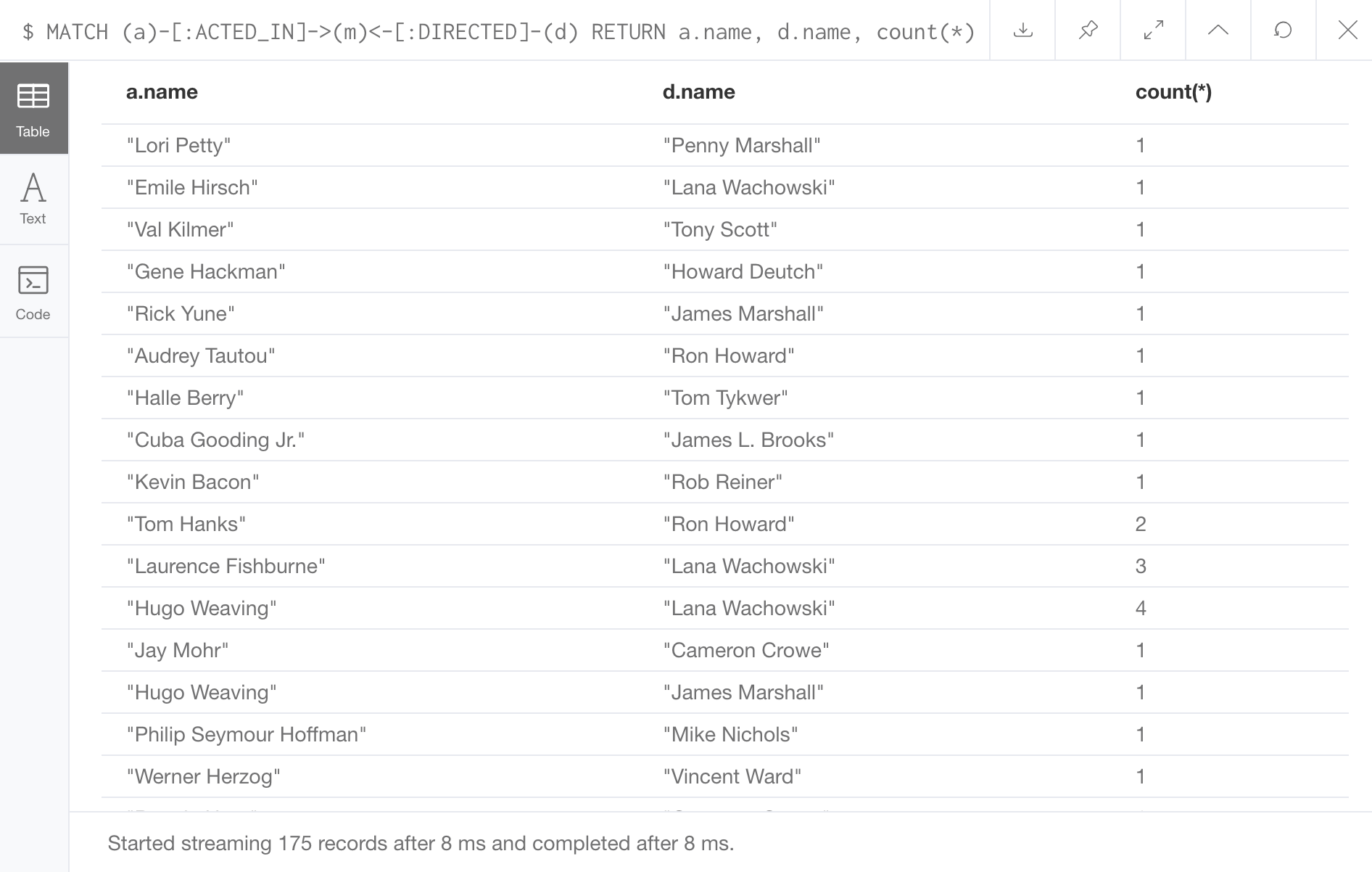
Collecting results
Cypher has a built-in function, collect() that enables you to aggregate a value into a list.
Here is an example where we collect the list of movies that Tom Cruise acted in:
MATCH (p:Person)-[:ACTED_IN]->(m:Movie)
WHERE p.name ='Tom Cruise'
RETURN collect(m.title) AS `movies for Tom Cruise`Here is the result returned:

In Cypher, there is no "GROUP BY" clause as there is in SQL. The graph engine uses non-aggregated columns as an automatic grouping key.
Counting results
The Cypher count() function is very useful when you want to count the number of occurrences of a particular query result.
If you specify count(n), the graph engine calculates the number of occurrences of n.
If you specify count(*), the graph engine calculates the number of rows retrieved, including those with null values.
When you use count(), the graph engine does an implicit group by based upon the aggregation.
Here is an example where we count the paths retrieved where an actor and director collaborated in a movie and the count() function is used to count the number of paths found for each actor/director collaboration.
MATCH (actor:Person)-[:ACTED_IN]->(m:Movie)<-[:DIRECTED]-(director:Person)
RETURN actor.name, director.name, count(m) AS collaborations, collect(m.title) AS moviesHere is the result returned:
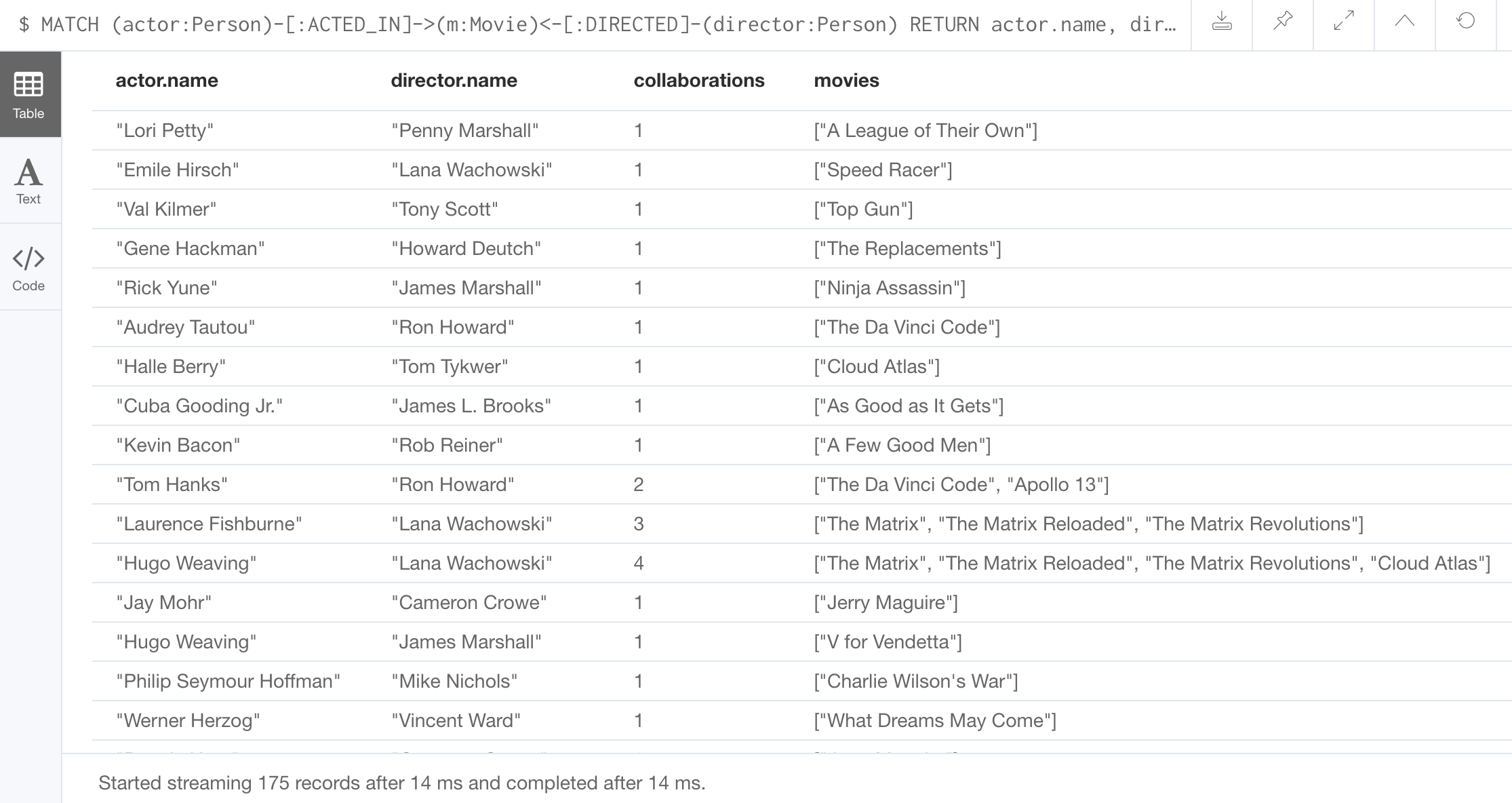
There are more aggregating functions such as min() or max() that you can also use in your queries.
These are described in the Aggregating Functions section of the Neo4j Cypher Manual.
Additional processing using WITH
During the execution of a MATCH clause, you can specify that you want some intermediate calculations or values that will be used for further processing of the query, or for limiting the number of results before further processing is done.
You use the WITH clause to perform intermediate processing or data flow operations.
Here is an example where we start the query processing by retrieving all actors and their movies.
During the query processing, we want to only return actors that have 2 or 3 movies.
All other actors and the aggregated results are filtered out. This type of query is a replacement for SQL’s "HAVING" clause.
The WITH clause does the counting and collecting, but is then used in the subsequent WHERE clause to limit how many paths are visited.
MATCH (a:Person)-[:ACTED_IN]->(m:Movie)
WITH a, count(a) AS numMovies, collect(m.title) as movies
WHERE numMovies > 1 AND numMovies < 4
RETURN a.name, numMovies, moviesHere is the result returned:
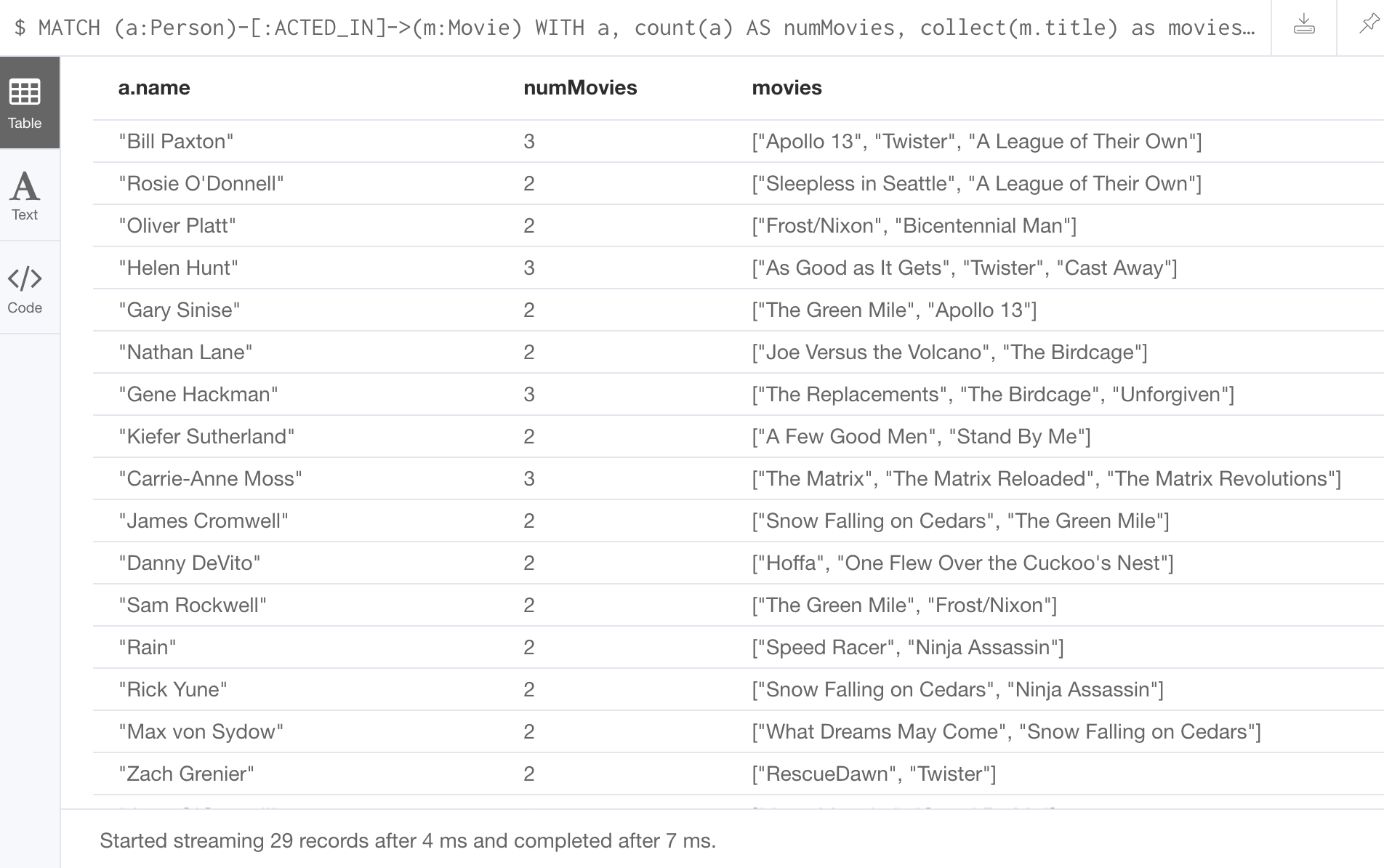
When you use the WITH clause, you specify the variables from the previous part of the query you want to pass on to the next part of the query.
In this example, the variable a is specified to be passed on in the query, but m is not. Since m is not specified to be passed on, m will not be available later in the query.
Notice that for the RETURN clause, a, numMovies, and movies are available for use.
You have to name all expressions with an alias in a WITH that are not simple variables.
|
Here is another example where we want to find all actors who have acted in at least five movies, and find (optionally) the movies they directed and return the person and those movies.
MATCH (p:Person)
WITH p, size((p)-[:ACTED_IN]->(:Movie)) AS movies
WHERE movies >= 5
OPTIONAL MATCH (p)-[:DIRECTED]->(m:Movie)
RETURN p.name, m.titleHere is the result returned:

In this example, we first retrieve all people, but then specify a pattern in the WITH clause where we calculate the number of :ACTED_IN relationships retrieved using the size() function. If this value is greater than five, we then also retrieve the :DIRECTED paths to return the name of the person and the title of the movie they directed. In the result, we see that these actors acted in more than five movies, but Tom Hanks is the only actor who directed a movie and thus the only person to have a value for the movie.
Exercise 5: Controlling query processing
In the query edit pane of Neo4j Browser, execute the browser command:
:play intro-neo4j-exercises
and follow the instructions for Exercise 5.
Controlling how results are returned
Next, you will learn some additional Cypher techniques for controlling how results are returned from a query.
Eliminating duplication
You have seen a number of query results where there is duplication in the results returned.
In most cases, you want to eliminate duplicated results.
You do so by using the DISTINCT keyword.
Here is a simple example where duplicate data is returned. Tom Hanks both acted in and directed the movie, That Thing You Do, so the movie is returned twice in the result stream:
MATCH (p:Person)-[:DIRECTED | :ACTED_IN]->(m:Movie)
WHERE p.name = 'Tom Hanks'
RETURN m.released, collect(m.title) AS moviesHere is the result returned:
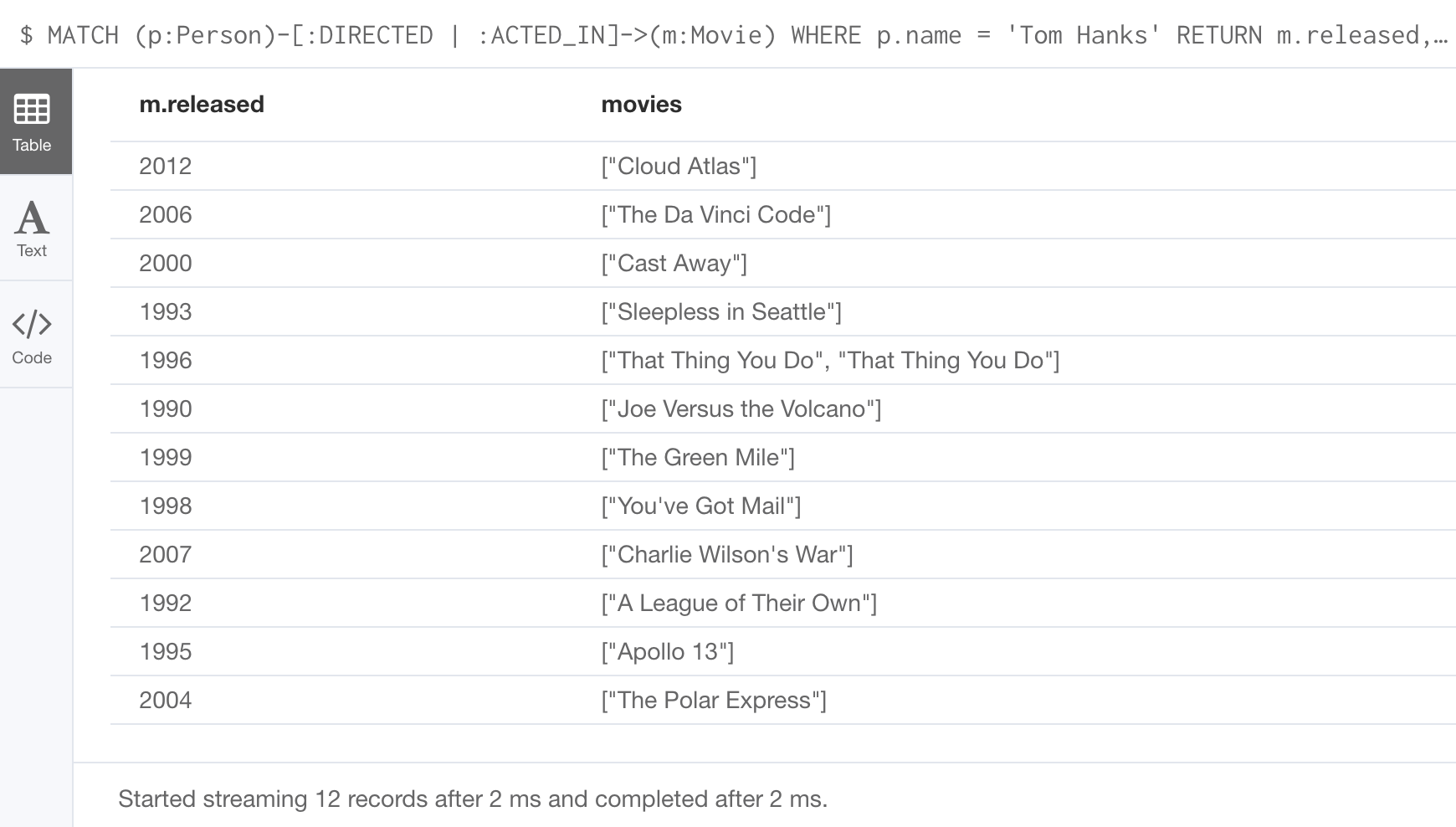
We can eliminate the duplication by specifying the DISTINCT keyword as follows:
MATCH (p:Person)-[:DIRECTED | :ACTED_IN]->(m:Movie)
WHERE p.name = 'Tom Hanks'
RETURN m.released, collect(DISTINCT m.title) AS moviesHere is the result returned:
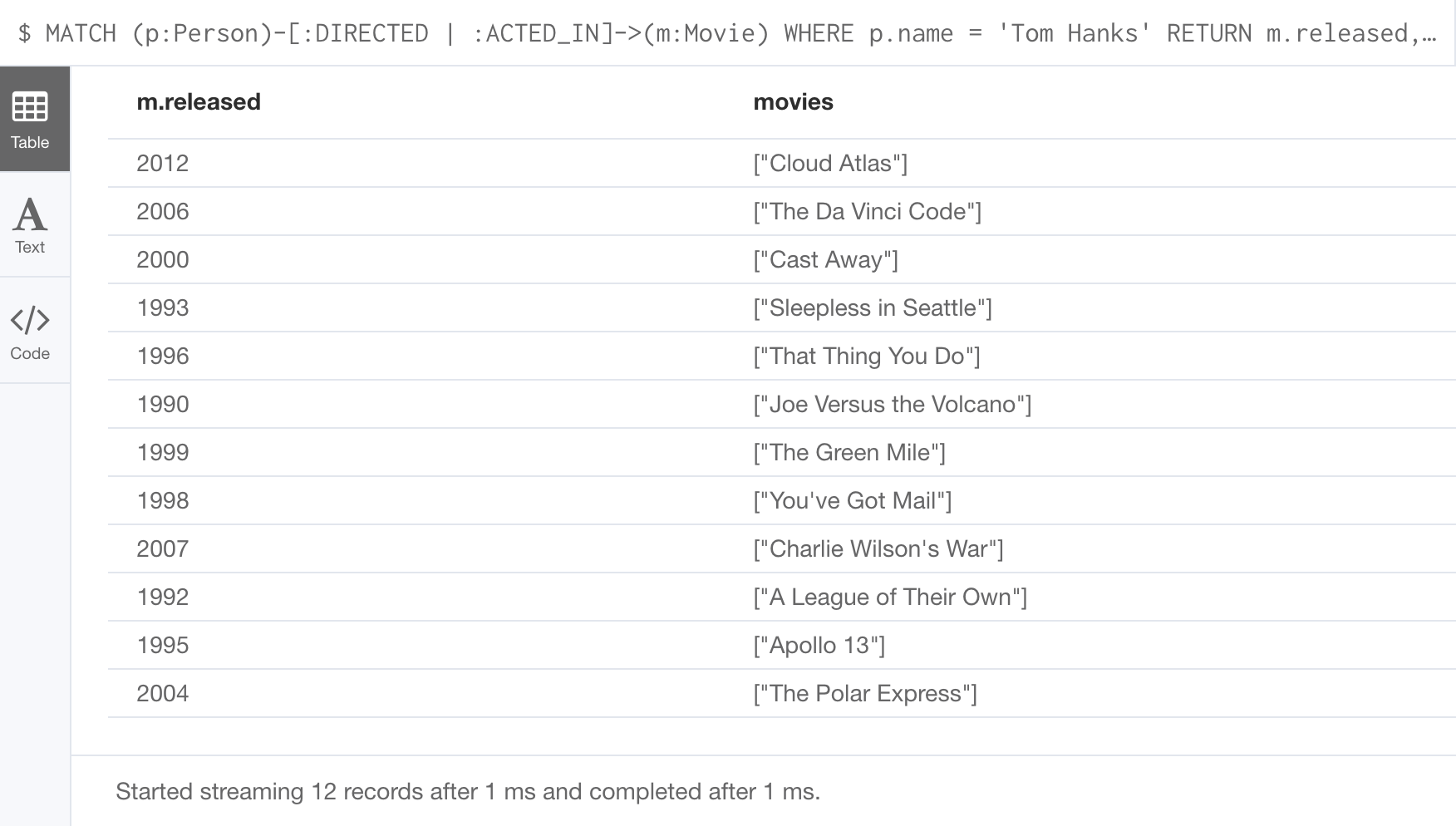
Using WITH and DISTINCT to eliminate duplication
Another way that you can avoid duplication is to with WITH and DISTINCT together as follows:
MATCH (p:Person)-[:DIRECTED | :ACTED_IN]->(m:Movie)
WHERE p.name = 'Tom Hanks'
WITH DISTINCT m
RETURN m.released, m.titleHere is the result returned:
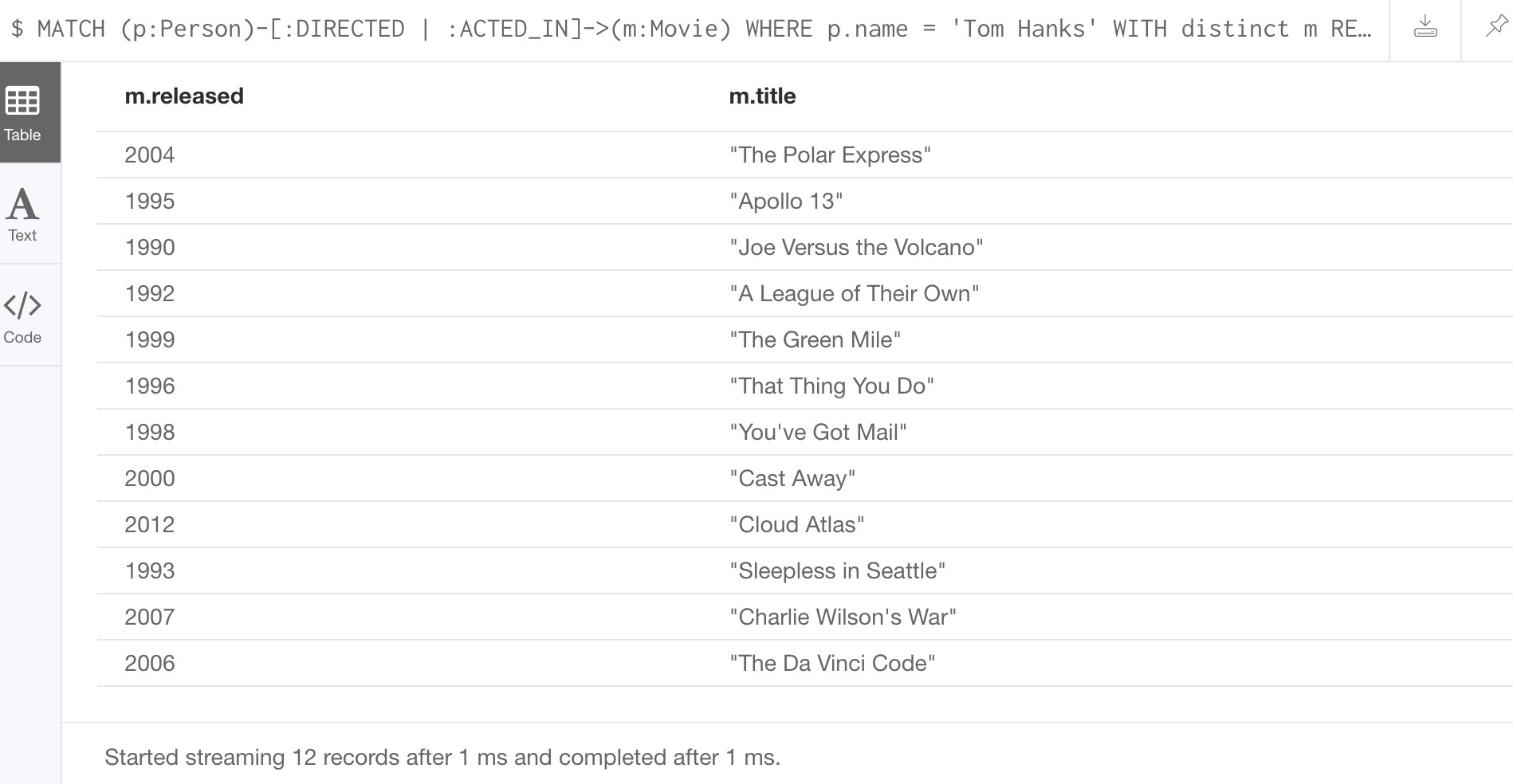
Ordering results
If you want the results to be sorted, you specify the expression to use for the sort using the ORDER BY keyword and whether you want the order to be descending using the DESC keyword.
Ascending order is the default.
Note that you can provide multiple sort expressions and the result will be sorted in that order.
Just as you can use DISTINCT with WITH to eliminate duplication, you can use ORDER BY with WITH to control the sorting of results.
In this example, we specify that the release date of the movies for Tom Hanks will be returned in descending order.
MATCH (p:Person)-[:DIRECTED | :ACTED_IN]->(m:Movie)
WHERE p.name = 'Tom Hanks'
RETURN m.released, collect(DISTINCT m.title) AS movies ORDER BY m.released DESCHere is the result returned:
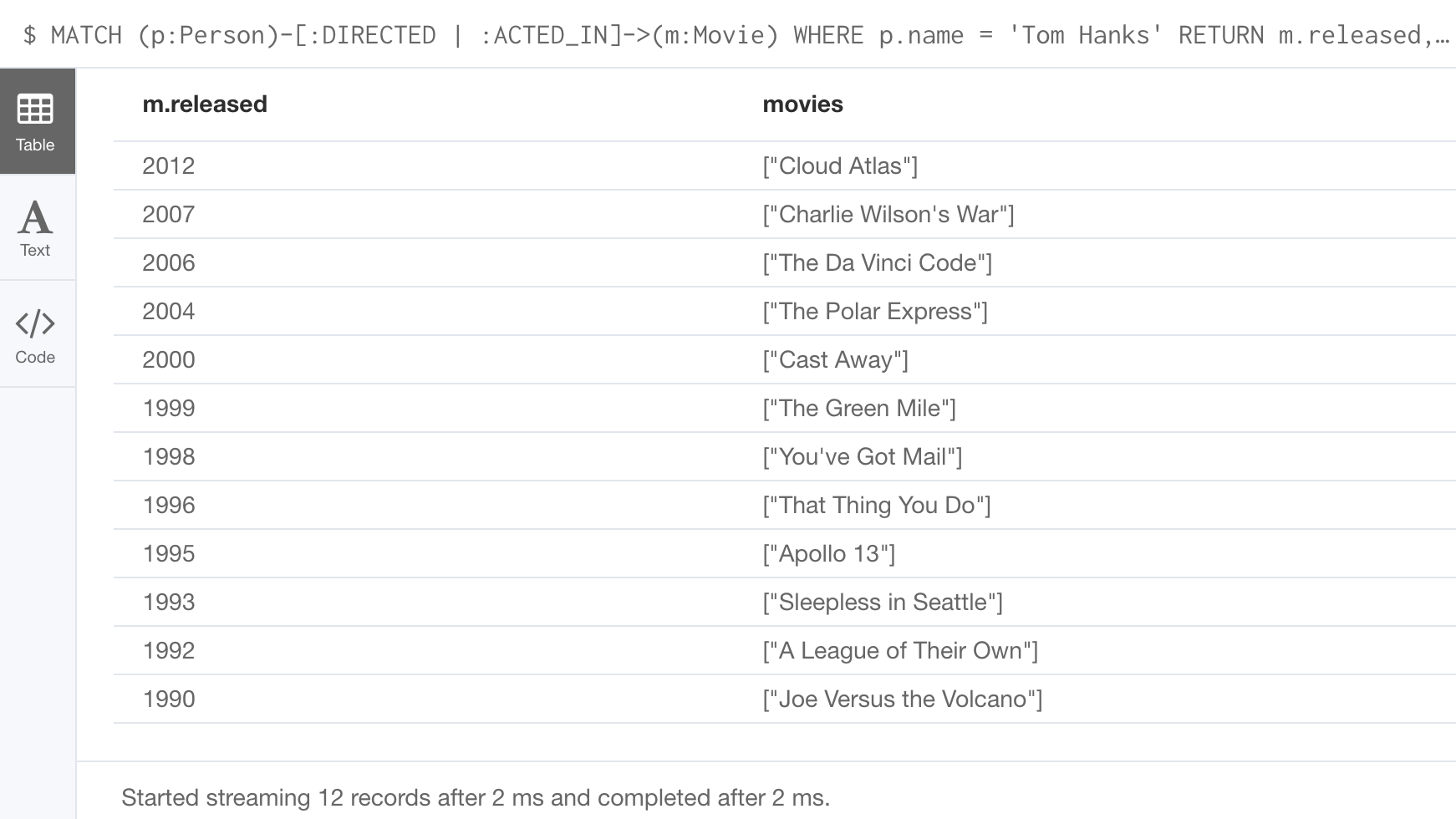
Limiting the number of results
Although you can filter queries to reduce the number of results returned, you may also want to limit the number of results.
This is useful if you have very large result sets and you only need to see the beginning or end of a set of ordered results.
You can use the LIMIT keyword to specify the number of results returned. Furthermore, you can use the LIMIT keyword with the WITH clause to limit results.
Suppose you want to see the titles of the ten most recently released movies.
You could do so as follows where you limit the number of results using the LIMIT keyword as follows:
MATCH (m:Movie)
RETURN m.title as title, m.released as year ORDER BY m.released DESC LIMIT 10Here is the result returned:
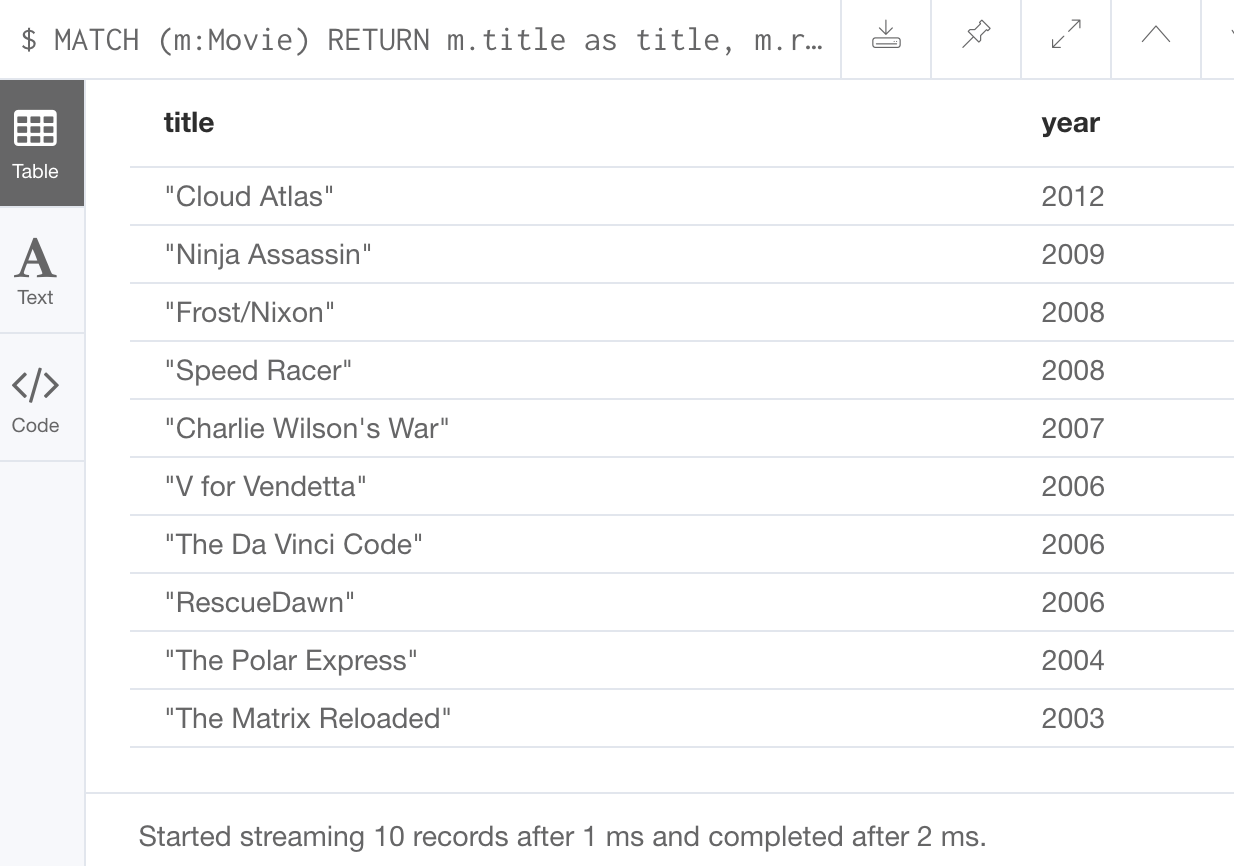
Controlling the number of results using WITH
Previously, you saw how you can use the WITH clause to perform some intermediate processing during a query. You can use the WITH clause to limit the number of results.
In this example, we count the number of movies during the query and we return the results once we have reached 5 movies:
MATCH (a:Person)-[:ACTED_IN]->(m:Movie)
WITH a, count(*) AS numMovies, collect(m.title) as movies
WHERE numMovies = 5
RETURN a.name, numMovies, moviesHere is the result returned:

Exercise 6: Controlling results returned
In the query edit pane of Neo4j Browser, execute the browser command: kbd:
[:play intro-neo4j-exercises]
and follow the instructions for Exercise 6.
Working with Cypher data
Thus far, you have specified both string and numeric types in your Cypher queries.
You have also learned that nodes and relationships can have properties, whose values are structured like JSON objects.
You have also learned that the collect() function can create lists of values or objects where a list is comma-separated and you can use the IN keyword to search for a value in a list.
Next, you will learn more about working with lists and dates in Cypher.
Lists
There are many built-in Cypher functions that you can use to build or access elements in lists.
A Cypher map is list of key/value pairs where each element of the list is of the format key: value. For example, a map of months and the number of days per month could be:
[Jan: 31, Feb: 28, Mar: 31, Apr: 30 , May: 31, Jun: 30 , Jul: 31, Aug: 31, Sep: 30, Oct: 31, Nov: 30, Dec: 31]
You can collect values for a list during a query and when you return results, you can sort by the size of the list using the size() function as follows:
MATCH (a:Person)-[:ACTED_IN]->(m:Movie)
WITH m, count(m) AS numCast, collect(a.name) as cast
RETURN m.title, cast, numCast ORDER BY size(cast)Here is the result returned:
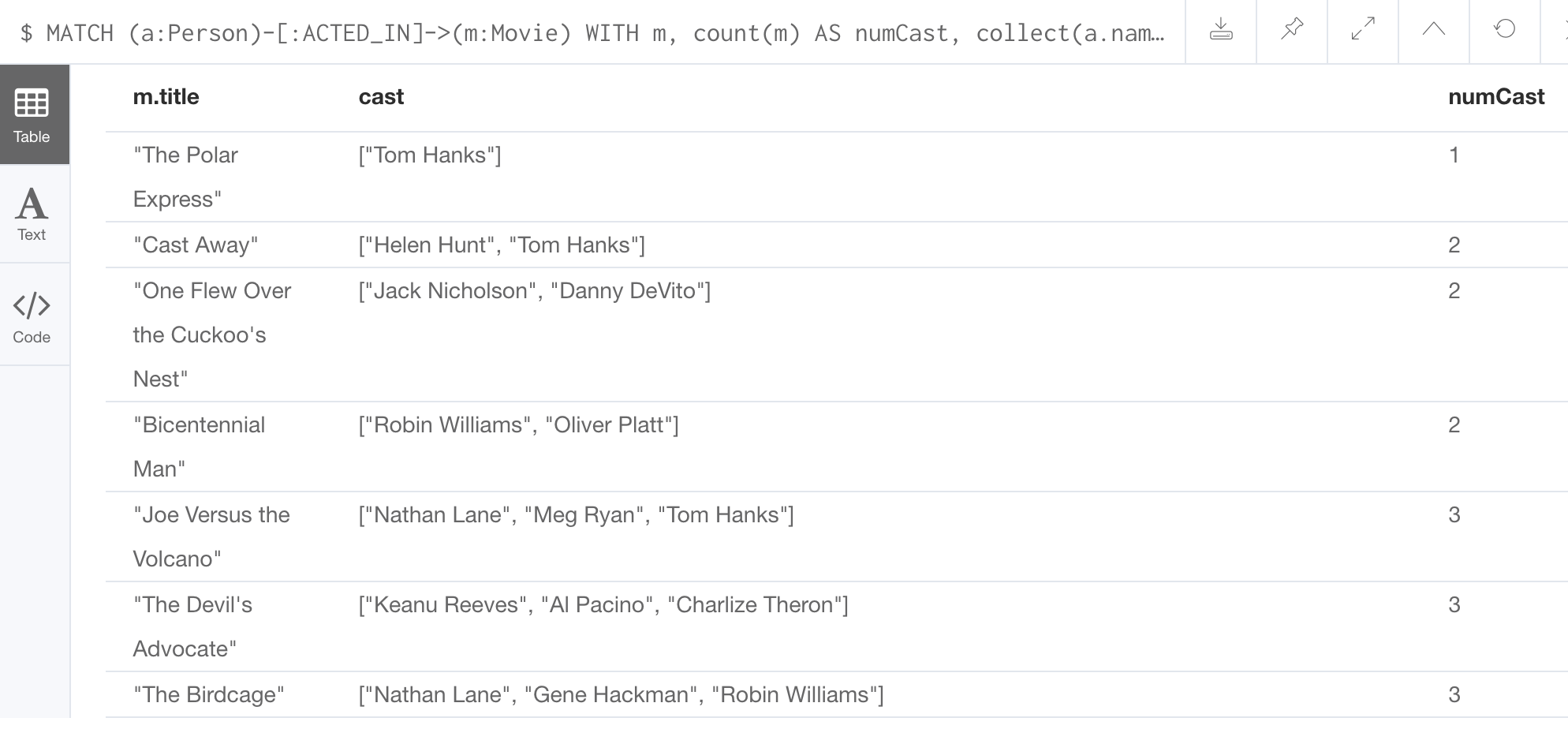
You can read more about working with lists in the List Functions section of the Neo4j Cypher Manual.
Unwinding lists
There may be some situations where you want to perform the opposite of collecting results, but rather separate the lists into separate rows. This functionality is done using the UNWIND clause.
Here is an example where we create a list with three elements, unwind the list and then return the values. Since there are three elements, three rows are returned with the values:
WITH [1, 2, 3] AS list
UNWIND list AS row
RETURN list, rowHere is the result returned:

Notice that there is no MATCH clause. You need not query the database to execute Cypher statements, but you do need the RETURN clause here to return the calculated values from the Cypher query.
The UNWIND clause is frequently used when importing data into a graph.
|
Dates
Cypher has a built-in date() function, as well as other temporal values and functions that you can use to calculate temporal values. You use a combination of numeric, temporal, spatial, list and string functions to calculate values that are useful to your application.
For example, suppose you wanted to calculate the age of a Person node, given a year they were born (the born property must exist and have a value).
Here is an example Cypher to retrieve all actors from the graph, and if they have a value for born, calculate the age value.
MATCH (actor:Person)-[:ACTED_IN]->(:Movie)
WHERE exists(actor.born)
// calculate the age
with DISTINCT actor, date().year - actor.born as age
RETURN actor.name, age as `age today`
ORDER BY actor.born DESCHere is the result returned:
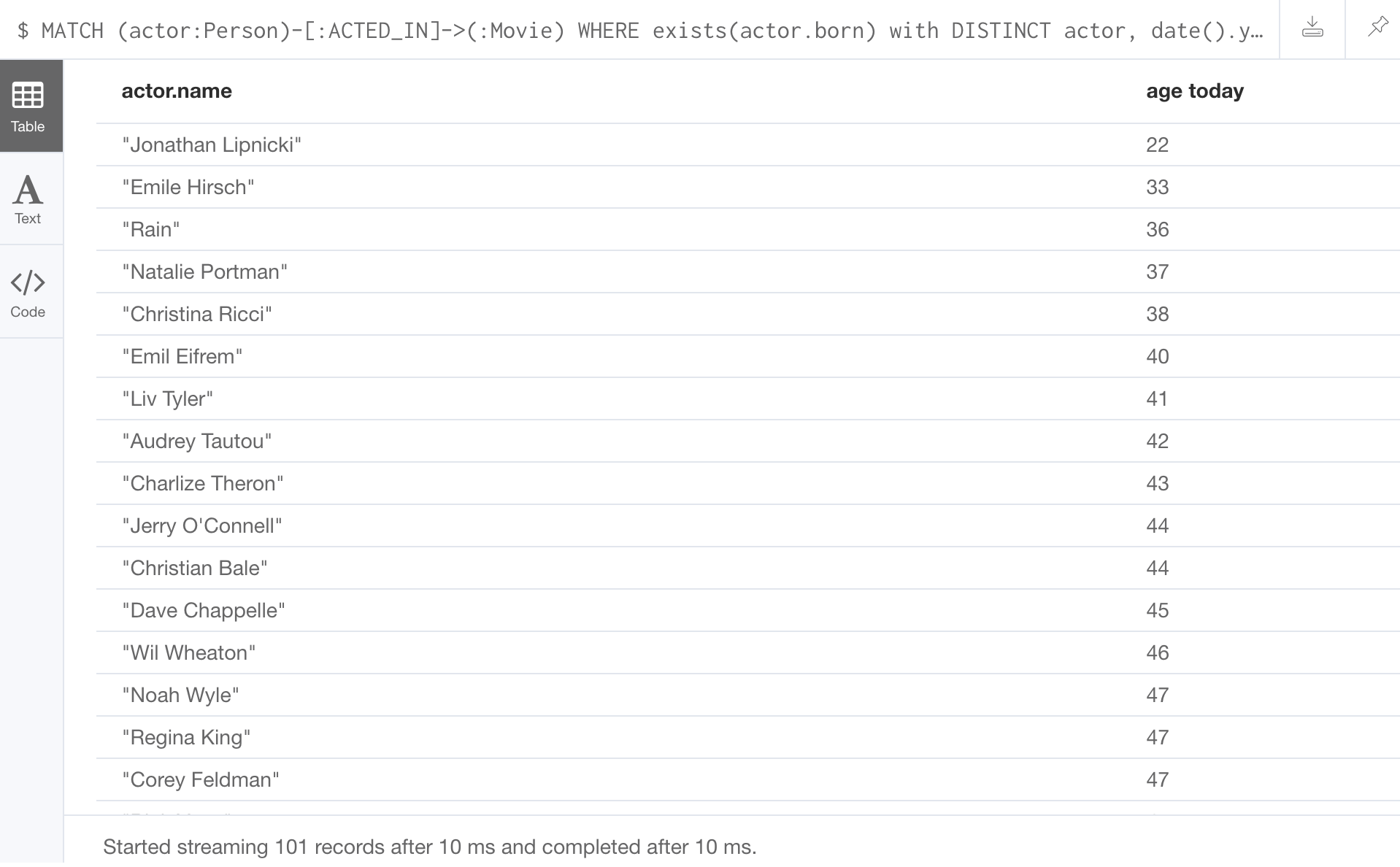
Consult the Neo4j Cypher Manual for more information about the built-in functions available for working with data of all types:
-
Predicate
-
Scalar
-
List
-
Mathematical
-
String
-
Temporal
-
Spatial
Check your understanding
Question 1
Suppose you want to add a WHERE clause at the end of this statement to filter the results retrieved.
MATCH (p:Person)-[rel]->(m:Movie)<-[:PRODUCED]-(:Person)What variables, can you test in the WHERE clause:
Select the correct answers.
-
p
-
rel
-
m
-
PRODUCED
Question 2
Suppose you want to retrieve all movies that have a released property value that is 2000, 2002, 2004, 2006, or 2008. Here is an incomplete Cypher example to return the title property values of all movies released in these years.
MATCH (m:Movie)
WHERE m.released XX [2000, 2002, 2004, 2006, 2008]
RETURN m.titleWhat keyword do you specify for XX?
Select the correct answer.
-
CONTAINS
-
IN
-
IS
-
EQUALS
Summary
You can now write Cypher statements to:
-
Filter queries using the
WHEREclause -
Control query processing
-
Control what results are returned
-
Work with Cypher lists and dates
Need help? Ask in the Neo4j Community